Travelling in a Motorhome with your Dog
One of the main reasons we chose a motorhome as our form of transport was the fact we could take our dog Charlie (I know, not the most imaginative name!), a King Charles Cavalier Spaniel with us everywhere we went. Since making that decision we’ve had three motorhomes, travelled to over 35 countries on two continents, and Charlie’s been with us throughout. We learned a few things about having a dog in a motorhome, so to try and help others thinking about doing something similar, this blog post aims to sum up what we sussed out.

Before Setting Off – The Pet Passport/Animal Health Certificate
If you’re thinking of touring outside the UK, then your pet need either an EU Pet Passport or an Animal Health Certificate (depending on where in the United Kingdom you live). With these you can get back into the UK, after having travelled anywhere in the world, without placing your beloved pooch in quarantine. You’ll need the paperwork in place before you leave the UK, and your local vet will be able to issue them for you. They can take a few weeks to arrange, so best head to the vets sooner rather than later.
There are some additional things to be aware of:
- Some countries have additional entry requirements. The UK and parts of Scandinavia require a worming treatment to be carried out by a vet prior to each re-entry into the country, for example, and it’s worth chatting with your vet about this so you’re aware of what you need to do.
- Some countries may not allow certain breeds. We’ve never had this problem, but it might be worth looking into it if your breed might be considered (by the authorities) as ‘dangerous’.
The terms of the Pet Passport and Animal Health Certificates change from time to time, and it’s worth staying up to speed by consulting the government’s website about taking your pet abroad.

What to Take With You
Here’s a list of the things we take with us when we leave the UK (it’s part of our motorhome packing list which contains everything we had in our van for a year long tour of Europe):
- His travel documentation – pet passport or animal health certificate
- The documentation showing his history of vaccinations
- An initial supply of dog food and some of his favourite treats
- His lead and collar (his collar has a metal tag with our international phone numbers)
- A supply of dog poo bags
- A supply of his arthritis medication – enough to last the whole tour
- His soft bed and blanket
- Some old towels for cleaning or drying him, or for wetting him down when he’s hot, or to put him on while we trim his fur
- Tick twisters – we use treatments but on occasion one will cling on and has to be manually removed – we’ve got these O’Tom ones and the two sizes have always been enough for the smallest and largest ticks
- Doggy shampoo
- Ear drops (he used to get the occasional infection)
- His dog coat, for walks in the wet or cold
- Claw trimmers
- Scissors for ear hair trimming
- His in-van water and food bowls
- Fur comb and flea comb
- Pet fur clippers (which double up as beard and hair trimmers for me) – we have Wahl ones like this, which are very good
- A fold-up, quick-drying water and food bowl – handy for taking out and about
- Proactive, generic worming tablets (like these) you can’t always get these, for example at a vets in Italy they told us worming treatments are only used for a dog which already has worms there, and wanted to know what type of worms he had
- Initial tick and flea treatments until we get a Scalibor collar
- Tooth brush and doggy tooth paste
- His toys – although he’s almost 11 now and has no interest in them!
- Scales, so we can weigh out his food when we switch brands

What You Can Fairly Easily Get on While the Road
Here’s a list of the things we don’t worry too much about before we set off, as we know we can get them on the road:
- Dog food – this is available everywhere, even in Morocco, although you’re unlikely to find UK brands so if you have a picky pooch then best to stock up for the whole trip
- Booster jabs – we’ve got Charlie’s booster jabs done by vets abroad without any issues
- Collars or Spot on treatments which protect against ticks, fleas and sand flies (which carry Leishmaniasis). We’ve used Scalibor collars in the past, bought at vets abroad – see below.
- Dog poo bags – in some countries the authorities provide these for free in dispensers on the street. In others you can buy them in shops,in Morocco they had none, not even nappy sacks or sandwich bags so it was a good job we stocked up.
- Most things really – leads, harnesses, toys, weird bits of dried liver, name tags, coats, you name it.

Public Transport and Pets Abroad
Different countries have different rules around taking pets on public transport. Some won’t allow it. Some will, but only if the dog has a muzzle. Some say you need a muzzle, but in practice only seem to enforce it for certain dogs. Some require the dog to be in a travel carrier (which Charlie won’t fit in). Some will allow any dog as long as it’s not dangerous.
The ones which do allow dogs may or may not require you to buy a ticket for her or him. Some inspectors will laugh in your face at the fact that, yes, you’re supposed to have a ticket, but not for eeny teeny weeny leedle dogs like yours. Hahahahah! (yes Italy, I’m talking about you).
The good news is, in among all this red tape, the fact that motorhomes in Europe can frequently get close enough to wherever you want to be, you can walk to your destination with your pet. Big cities are the notable exception, where you may need to leave your pet in the motorhome somewhere cool and secure, or leave the cities for another time.
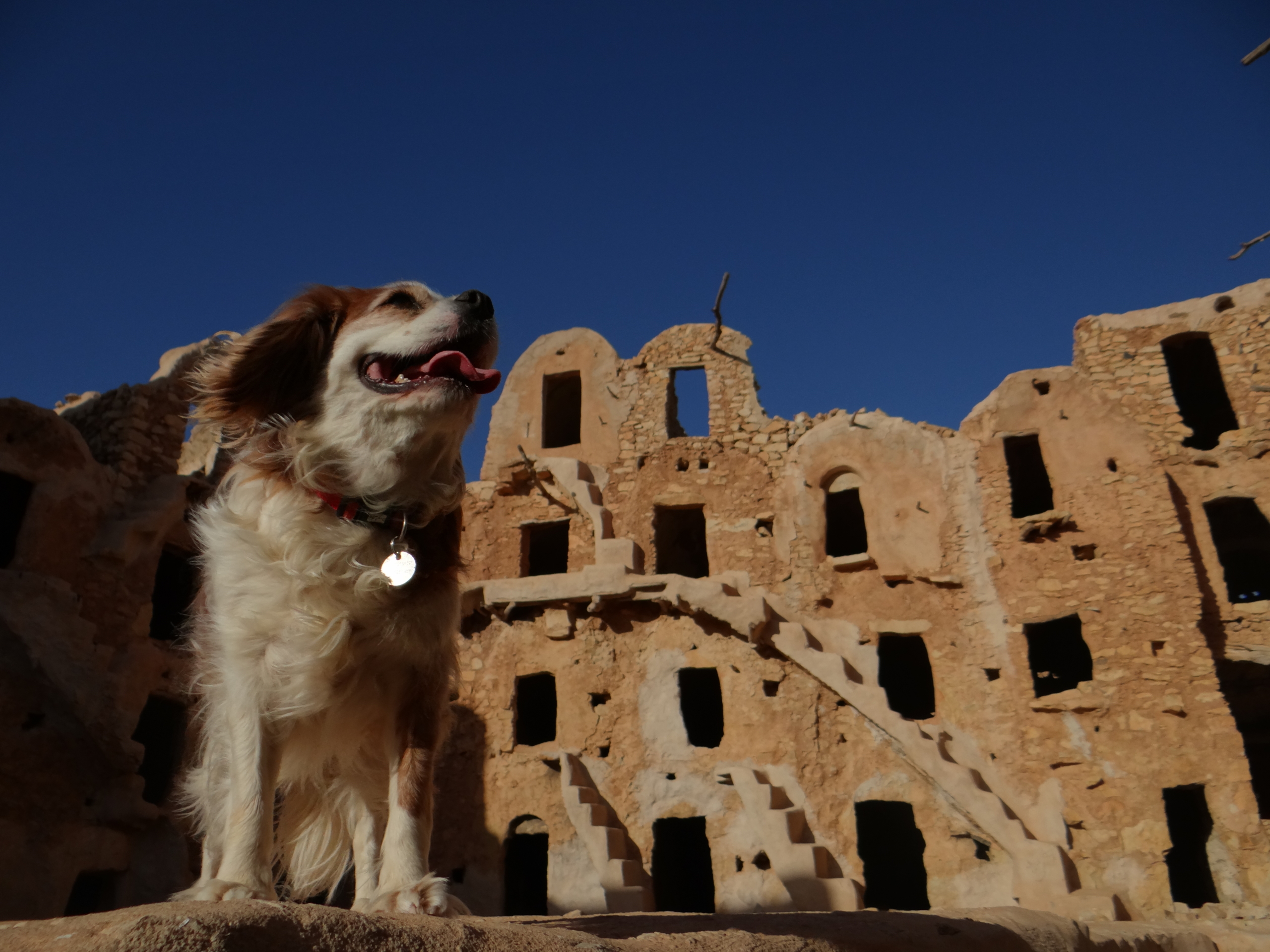
Using Vets Abroad
This was a source of trepidation for us a few years back, but again there’s good news, it doesn’t need to be a worry for you. We’ve used vets in Estonia, Germany, France, Slovenia, Greece, Spain, Italy and Portugal, and can report back that the experiences have been a very good:
- The quality of the vets has always looked top-notch, the same level of cleanliness as the UK. We’ve never had a major issue, so we can’t comment on surgery ability etc, but for basic procedures we’ve found the surgeries to be great quality
- It’s usually easy enough to find vets using Google, just looking as you drive through towns or asking around
- The vets very often speak English. Having Google Translate on your phone is handy as a last resort
- We’ve rarely made an appointment – just turning up often seems to be completely acceptable – but we do book for the worming treatment when returning to the UK. We do this a few days beforehand, and use email or Facebook messenger (more and more vets seem to use this) so we don’t have to strangle their language over the phone
- Note that if you need medication for your dog, pharmacies in some countries may sell it and although you might feel a bit odd asking for it, they can be more convenient than seeking out a vets
One point to note: foreign vets speaking English might not apply the same level of tact you we enjoy from our UK vet. If your dog is overweight, needs claws clipping, or is getting old, you might be surprised at just how blunt the message can be compared with here in Blighty.
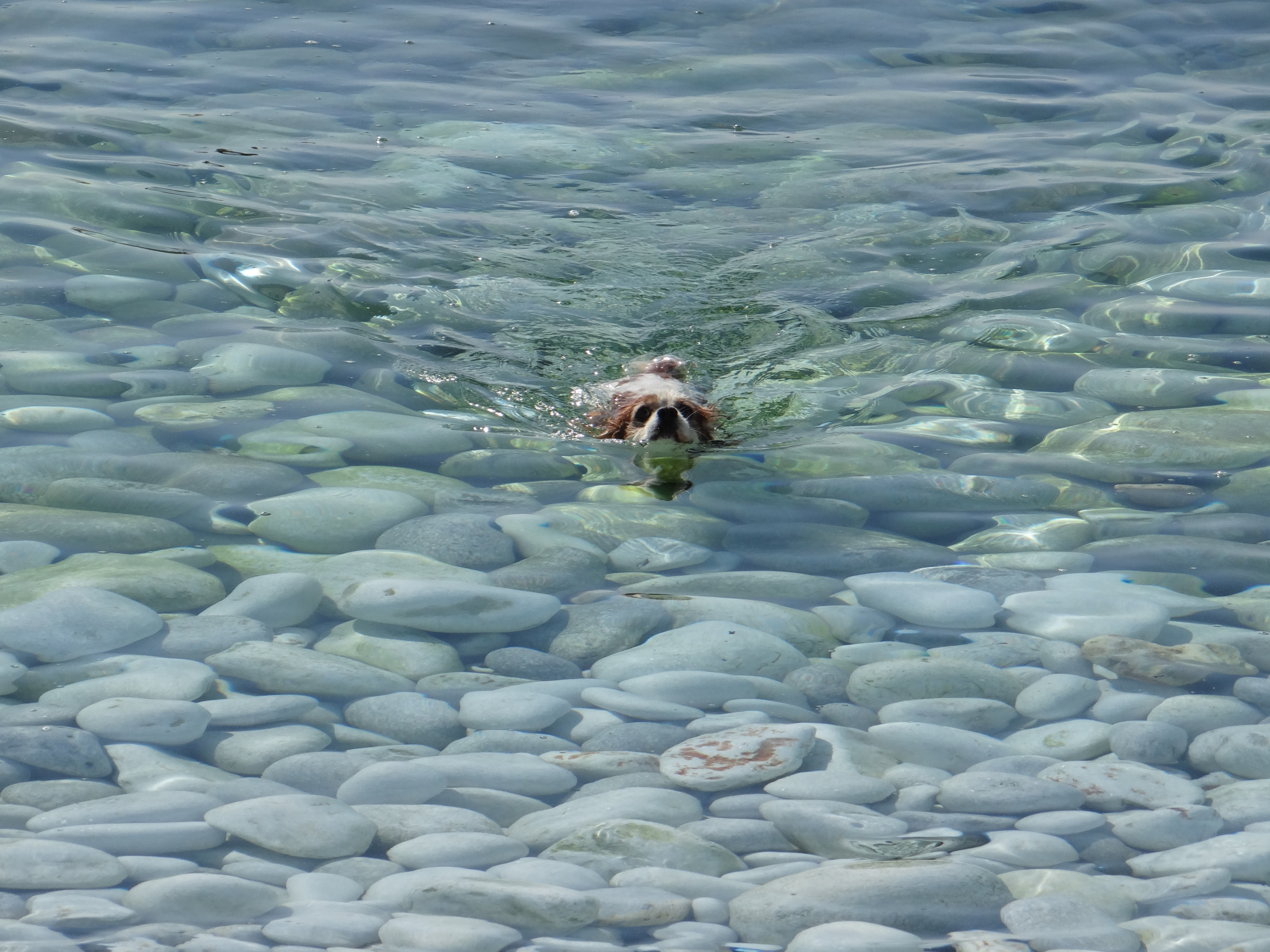
Finding a Vet for Re-Entry to the UK
 The Pet Passport scheme for people in England, Wales and Scotland has been replaced by Animal Health Certificates since the UK left the EU. Vets across Europe and well aware of it and the requirements for re-entry to the UK. Most vets we’ve used have spoken good English, and have accepted bookings via email or Facebook, so no need to call someone. We tend to book an appointment at a vets a few days before we return, bearing in mind that (at the time of writing), the vet needs to give a worming treatment between 5 days and 24 hours before you touch down in the UK.
The Pet Passport scheme for people in England, Wales and Scotland has been replaced by Animal Health Certificates since the UK left the EU. Vets across Europe and well aware of it and the requirements for re-entry to the UK. Most vets we’ve used have spoken good English, and have accepted bookings via email or Facebook, so no need to call someone. We tend to book an appointment at a vets a few days before we return, bearing in mind that (at the time of writing), the vet needs to give a worming treatment between 5 days and 24 hours before you touch down in the UK.
My guess is almost any vets will know the scheme, as it must be a pretty good money spinner, and they seem to charge between €20 and €50 a dog, depending on the weight of the dog, whether you provide the medication, how through the check-up is, and how posh they are. We came across this handy Google map of vets for returning to the UK a while back Jay wrote this blog post about the trip to the vets on our last return home to the UK – things have changed a bit now, but it’s still worth a read about what to expect.
Driving in a Motorhome With a Dog
Charlie’s pretty easy going when we’re driving. We keep the journeys short most of the time, between 30 minutes and 3 hours, and if he’s showing any signs of wanting out, we stop for him. He sleeps much of the time while we drive, and has learned to wedge himself in so he doesn’t roll about, even on hairpins. Some folks pop their dogs into cages for travel, as in some countries such as Spain the dog should be restrained while in the vehicle so it doesn’t distract the driver. We place a guard between the cab and main living area, so he can’t get under the driver’s seat, and he’s been fine over the years like that, and we haven’t been stopped.
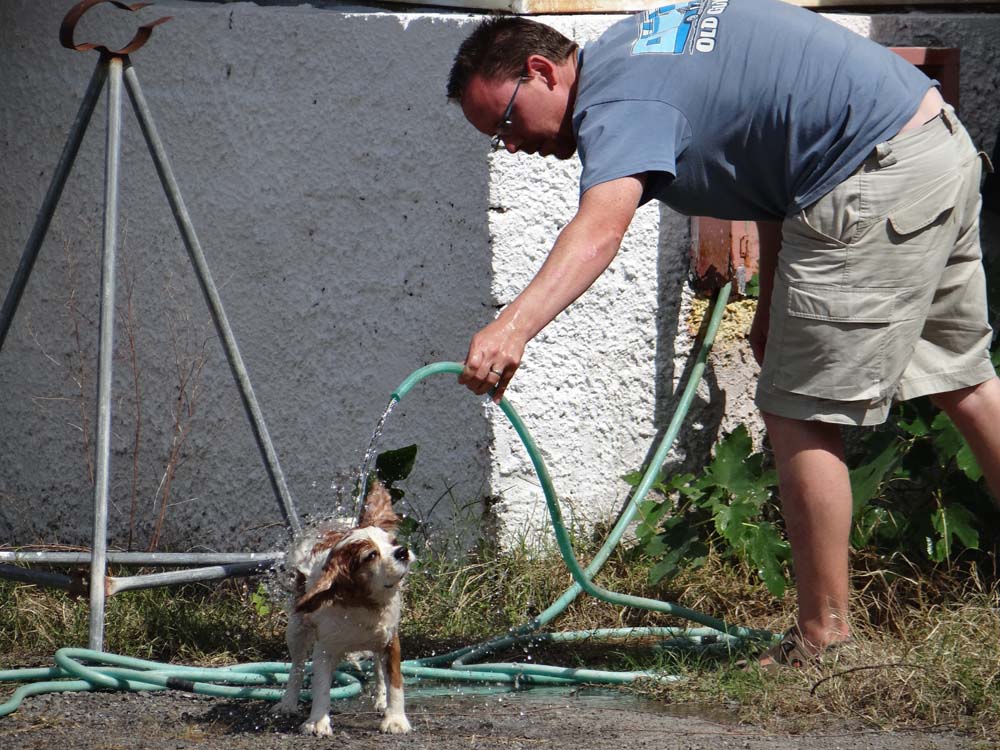
New Risks to be Aware Of
Taking your pooch outside the UK, and touring around Europe, can introduce a few new risks to be aware of and plan for. The ones we’ve come across are listed below. It’s worth discussing your tour with your vets too, as they’re the experts and know your dog, but be aware that not all UK vets are fully aware of conditions which occur outside the UK.
- Leishmaniasis – this is a disease carried by sand flies and is endemic in parts of mainland Europe (mainly around the Mediterranean) and North Africa. Tick and flea treatment sold in the UK doesn’t usually provide protection against it. We use Scalibor collars while abroad, which we buy once we’re over there from a local vets because they know what issues there are in the area. You can also pick the up the collars at the pharmacy or supermarket, and be sure to check the packaging for specific mention of leishmaniasis. Some dogs have allergic reactions to the collars (another reason why we buy ours from a vet), if you don’t want to use a collar on your dog, Advantix is a spot on treatment that also protects against leishmaniasis.
- Rat poison – this could happen anywhere of course but it happened to Charlie on a motorhome campsite in Sicily. Fortunately we saw him eat one half of the brightly-coloured packet, and the other half stated it was rat poison in several languages. We made him sick with salt water and got him to a vet quickly, and he suffered no ill effects.
- Stray or guard dogs – some parts of Europe have problems with uncared for dogs, or dogs trained to be aggressive to protect property. We’ve not had much of an issue with them since we worked out running at them screaming tends to scare the be-Jesus out of them. Carrying a walking stick or umbrella can be a good ploy too, or bending down to pick up a stone if you’re concerned, as these poor animals will have felt the sting of sticks and stones in the past, and will keep their distance.
- Heat – southern Europe in summer can get very hot for prolonged periods of time. 30 to 40ºC heat can be a big problem when travelling with a dog in a motorhome. We try to be further north in summer to avoid it, but sometimes get it wrong. In those cases we don’t leave Charlie in the van on his own, we seek shade and pop a wet towel on him to keep him cool. Friends used a transcool unit, which was very effective when we had a go with it. It runs off 12v, so if you are planning to be somewhere hot for a long time it would be a good investment.
- Theft – there is a risk that your dog will be stolen. In several years of travel we only heard of this happening once, in Tunisia, when the owner never kept his dog on a lead. He went to the authorities and they tracked down his pooch and returned it unharmed.
- Just plain weird stuff – Charlie had difficulty breathing one night in Slovenia. The following morning we took him to the local vet first thing, who diagnosed an allergic reaction to something he’d sniffed up. What was it? No idea. he gave him and injection and handed over a course of tablets, and Charlie was back to normal quickly.
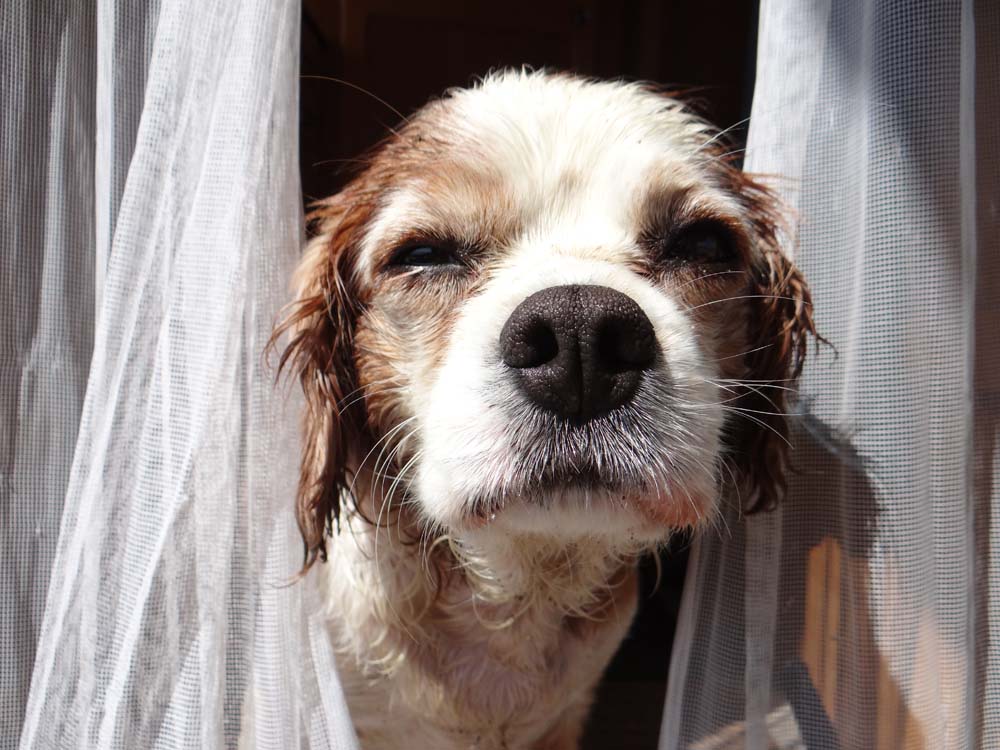
The Fun Stuff
Like my favourite bit of a meal, I’ve left the best bit until last.
Travelling with a dog is a heart-warming, endearing and fun experience. He’s an endless source of hilarity and loyalty, and acts as a fantastic ice breaker. He’s introduced us to a massive range of people, dog lovers in the guise of Tunisian kids, the Venice Port Authority, a gift shop owner on the side of Mount Vesuvius, a retired airline pilot in Greece and a huge range of other fascinating folks.
What’s the journey been like for him? I honestly have no idea, but he’s spent years almost 24 hours a day with the two of us, which I imagine he liked. I like to think he’s enjoyed having his paws in the Sahara, on the pumice lava fields on Etna, wet in the Arctic sea, and cold in the ice of the high Alps. He’s managed to get his jaws on all kinds of food; sardines, octopus, snails, freshly-fallen dates, chicken feet, camel meat, goat, camel poop and various kinds of tasty bone. I like to think he enjoys the wandering as much as we enjoy having him with us.
If you have any hints and tips for travelling with a pooch, please feel free to share them in the comments section below!
Cheers, Jay
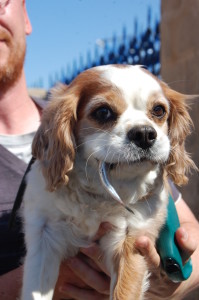
Free food, pooch style.
New to motorhome life,
planning your own motorhome adventure or
looking for the perfect gift for the motorhomer in your life?
Check out our OurTour range of books.





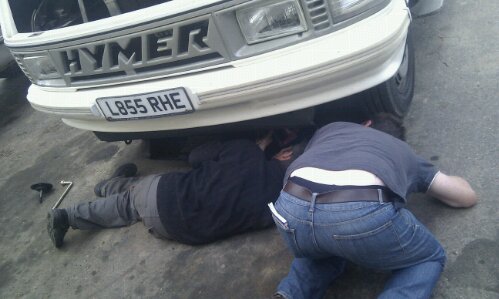




Great post and I’m sure this will be really useful to those new to travelling with their woofer(s). I’ve always taken my collies, sadly this year will be travelling with just one :-(. Having dogs with you is definitely an ice breaker when travelling and meeting locals and fellow travellers. The down side is occasionally is not being able to visit some of the iconic city sights and now there are lots of dog bans now in place on the popular beaches in France and Spain. However I tend to ask the locals where they go and as I generally travel in low season and I’m not really a city lover it’s not such a problem for me. One tip I would add is that you can supply your own wormer as long as it’s in date and the vet stamping your dog passport administers it. Useful to know if like me you belong to a pet scheme and pay a monthly fee for wormer, tick & flea treatment and annual vaccinations. Also in hot weather worth trying http://www.ebay.co.uk/itm/Pet-Cooling-Mat-Chill-Out-Bed-Hot-Weather-Heat-Relief-Cooling-Pad-Dog-Cat-IN-OUT-/152570418180. Procession Caterpillars are something to be mindful of see info http://www.dogtravelblog.co.uk/thinking-of-taking-your-dogs-abroad/what-about-those-processionary-caterpillars/ Finally if you are travelling via ferry certainly with Brittany Ferries book early if you want a kennel and there is a maximum no of animal which they permit to be carried in vehicles.
Oh my gosh, I had to show my husband these sweet photos of your beautiful dog. I’m in Seattle, WA, but the idea of driving a motor home through Europe sounds wonderful.
We’ve motorhomed a fair bit with our pooch and one thing I would recommend is asking your vet for some pro-kolin. (I think that’s what it’s called!) Its basically a tube of doggy immodium. Just in case! We’ve never had to use it while away but the very thought of my dog with the runs in a motorhome is the stuff of nightmares! It’s about £20 a tube, well worth-it for peace of mind.
I’ve noticed that you travelled to some countries that aren’t covered by pet passport. Is it easy enough getting back into the pet passport zone?
Hi Jon – yes, the Pet Passport is designed to enable you to return to the EU without needing additional paperwork. You need to check two things: even within the EU there might be a need for worming treatment to cross borders – Norway and the UK spring to mind. Also, when travelling out of the EU, some countries may have additional requirements to get into the non-EU country. For example, Morocco (technically, they don’t seem to enforce it) requires a ‘fit to travel’ certificate from Spain. As usual, I’d suggest talking to your vet before travelling to get the best advice. Jay
Hey guys, thanks for sharing this post.
My fiancé and I are about to embark on a trip through France. Spain and Portugal with our miniature dachshund, @DarceyDachshund! We can’t wait. Love to kkownif you have any good tips for locations that are great for the dogs while also taking in some amazing scenery.
We shooting some cooking videos out in the open air so would love some tips!
Cheers,
Mike
It’s worth noting that Finland, Norway and Sweden require a similar worming regime as the UK depending where you are arriving from. We spent money getting our dogs wormed in Estonia and passports updated only to find nobody checked at either the Finnish or Norwegian borders.
We did the same thing Tim. Charlie had his pet passport treatment in Estonia (€8 bargain) but we were waved straight off the ferry and into downtown Helsinki and there was nobody at the border post between Finland and Norway in the North. Can only assume spot checks are done. I do love the way people and authorities in Scandinavia assume everyone is as honest and law abiding as they are, I lost count of the number of honesty boxes etc.
Yikes, we didn’t know this. Came from Estonia to Finland about two and half weeks ago and Finland to Sweden last week. No one checked, no one asked!
We travelled on the ferry from Denmark to Norway a few weeks back, and our dog’s passport was checked for the worming treatment so best folks don’t risk it as there are definitely occasional checks :)
Great post, thanks. I’m looking at crossing to morocco in january with my dog. From your article it seems fairly straight forward going there and back as long as I have the EU pet passport. Was it as hassle-free as it seems? No extra treatments or certificates required going in either direction? Cheers
Hi Kevin. In theory you need a vet certificate on the way into Morocco from Spain, to say the animal is fit to travel. We weren’t asked for it by Moroccan customs, and the other people we knew or met dogs weren’t either. Going back into Spain you need a pet passport with the correct dates on the rabies jab. Best to check with your vet before leaving though, to be sure of the latest requirements. Cheers, Jay
To Kevin (and Jason), how did it go on taking your dog into Morocco?
I am trying to find out similar info for our house cat, what do we need? Pet passport, rabies vaccination etc? We are intending to travel down from the UK through France and Spain and into Morocco over a 6 week period and come back. We have done this before, but did not have a cat then!
I can not seem to find any relevant up to date information and the only info I can find says he has to have a Rabies jab, then blood sample taken no sooner than 30 days after jab, if this is the case we would have to stay in Morocco for 30 days or more.
We would hate to have to leave him behind in UK, its far too long.
Any advise or info would be gratefully received.
Thanks
Hi Deb. There’s no need for any treatment or vet checks in Morocco. The pet passport and associated rabies test have to be completed while the pet is in the EU. There is a fair bit of info at the address below, but your vet should be able to explain all the details for you. Cheers, Jay
https://www.gov.uk/take-pet-abroad/pet-passport
Hello Jay
Myself and my partner are off to Morocco in a couple of weeks. Do you know where I can get pet travel insurance for my dog? I’m covered on her pet insurance in Europe but Morocco is proving more difficult! Or don’t you bother? Thanks a lot. Esmée
Hi guys, we self-insure Charlie so I’m afraid I have no idea who might insure her over there. If your insurance covers Ceuta that could be an option – get to the motorway network and drive up there to get treatment under your current cover? Cheers, Jay
Great blog – thanks for posting this. I have been looking for something like this for a while and it is surprising that there aren’t more posts from motorhomers about taking their dogs.
We have been 3 times now. Just a couple of additional points:
One of our dogs is wheat intolerant, so we always take a supply of food to cover the whole trip. The longest we have been away for so far is a month so this has been straightforward.
We did have a sickness/diarrhoea problem with one of our dogs on our first trip. We had probiotic with us, and this did help. It is usually available over the counter now. We happened to be on a campsite in Spain and they were very helpful with booking a vet and giving us directions. The vet used google translate at one point, and this was very useful as our Spanish is pretty much non-existent.
One of our dogs is not good with strangers, so for the worming treatment before coming home we always ask the vet if we can give him the tablets ourselves, and they have always been happy with this. Obviously this needs to be done at the vets and they need to see it being given!
Happy travelling to all dog owners!
Good info, thanks David! Jay
I am going to spain and portugal in a couple of weeks i have a dog passport was it hard to find a vet on the way back as we are travling in a motorhome. I am a bit worried about finding one
Hi Gillian. Nah, every vet anywhere near a port earns plenty of cash from the scheme so they all know it well. If heading for the North France ports, these guys in St Omer are good and speak English. Best to book an appointment just to be safe, email them in English if you don’t fancy calling: http://cliniqueveterinaireduhautpont.chezmonveto.com/structure
What a lovely post, thanks!
We are so excited to found your blog!! Because you made our dream to visit Europe with our dog after our retirement ( 3 years time)will come true!! Our dog will be 9 years old 3 years time and do you think our dog is not too old to travel many European country by motor home?
Thank you.
Hi Yoko! Our Charlie was that old on his last tour, and he’s not done travelling yet! There are plenty of great vets across Europe if you need them, so we can’t see why the age of your pooch would be a problem! Cheers, Jay
Really useful, thank you! I’m taking my Mini schnauzer, who will turn 1 while I’m away on the Greek Cycladic islands in sep/October. You mentioned the scalibor or collar as a protection against leishmaniasis…are they easily available in Greece do you know….and the spot-on treatment? My vet is suggesting that Greta has a triple vaccination before she goes….
Hi Rosie. Yep, we went into a vets in Greece and they supplied the Scalibor collar. You don’t need Spot On while the dog has the collar. Some vets suggest keeping the collar dry, although the packaging said it was waterproof. The triple vaccination sounds like the yearly booster jabs? We found these can be done quite easily at any pet vets, take your record card so they can complete it. If your very in the UK prefers to do it before you go, that might be easier though, and give you a year’s peace of mind. Have fun, cheers, Jay
Hi Jason, thanks so much for the great info! We are interested in the route you took to get to Greece with Charlie? We were thinking about going from Croatia through to Montenegro, Albania and then on to Greece, but we are getting conflicting information on whether Pip can cross in / out of Albania and Montenegro with just a PETS passport – DEFRA said they need a titer test but the Albanian consulate said no! When you’re planning your tour who did you guys get in touch with to understand each country’s rules? It’s mind blowing!
Hi Rachel, we went from Italy to Greece, camping on board on a ferry in early April. It sounds like the DEFRA perspective is about getting back into the EU from Albania, not entering Albania. Joanne at ourbumble.com has done a lot of research into the same route as you, perhaps worth sharing notes with her? Good luck, cheers, Jay
Thank you, very helpful!! Will collect the collar on arrival as we drive past the vets on our way to where we’re staying. The triple vaccination was against leishmaniasis. Very expensive though, £199! It lasts a year. Did you use the collar all the time? We will be on the coast on both islands.
Hi Rosie, remember Leishmaniasis is endemic in most of southern Europe, so you might need to protect against it on your way to Greece too. Yes, we used the collar for a couple of months and it seemed to work perfectly. The vets told us some dogs have a skin reaction to them so you need to check the dog’s neck for the first couple of days. Cheers, Jay
Wow thank you for taking the time to do this its really lovely to know i am thinking of a road trip thru france, spain,greese,and italy to look for my forever home only problem is I have four dogs small 2chiachuchuas 1 chineese crested and a smorkey (maltease x yorkie) and I am wondering how many are allowed ?
Hi Tracey. A quick search comes back seeming to show 5 pets coming back into the UK as the maximum before commercial laws come into effect. This is the only reference I can see to the maximum number of pets. Have a word with your vet though; they’ll know better than me. Cheers, Jay https://www.gov.uk/take-pet-abroad/5-pets-other-animals
The picture of Charlie in the water with the stone in butiful were was this taken
Hi Paul. It was somewhere on the North Coast in France. Can’t exactly remember as it was several years ago (don’t we all look young!) but looking at our map it might have been Etretat. Can anyone else confirm? Ju x
Hi Jay
We are thinking of setting out to Southern Europe next February with our terrier. Have you had much experience of processionary caterpillars. Our dog is very inquisitive and we do worry that he might approach them before we have chance to realise what’s going on!
Any advice would be appreciated.
Thanks
Hi Judith, we’ve only seen them in Tunisia, so maybe they’re not that common? They were in a chain on the campsite ground under pines, so easy to spot and we opted to leave. Never seen them since. Cheers, Jay
Thank you for all this great information. We are planning a 2 month tour next summer with our spaniel Molly. The UK will have left the EU by then. Do you (or anyone else out there) know whether the Pet Passport scheme will change please?
Hi Lynn. As we understand it the PETS Scheme will probably stay in force after Brexit. But until the process is completed, we don’t **think** anything is set in stone. The only way to know is, we think, to wait and see what gets signed into UK law in the coming months. If anyone has any better info, let us know? Cheers, Jay
Hi guys, really enjoying your blogs and website, thanks for taking the time to do it!
We are planning a 6 month ish tour of France and Spain in October with our 8 year old Maltese terrier, Duffy and our 9 year old cat, Teddy. ( So deeply sorry for your loss of Charlie, he sounds like he had a great life with you )
Apprehensive about taking Teddy, but we are a family so no choice, he is used to being on a lead and we have bought a pet stroller – bit embarrassing but always wanted a baby – lol!
We are brand new to motorhoming and have bought a 14year old Peugeot Autocruise Starblazer – named Poodle, because that’s what we intend to do!
Really wanted your views on gas – did you change your gas containers so you could fill up abroad?
We have heard about Gas Lo and Gas It – but sounds expensive.
What have you done?
Many thanks and keep it going 😊
Best wishes Jane and Sue
Hi guys, yep we installed a GasIT self-refillable system. They’re pretty much essential if you plan to tour long-term across multiple countries. Search this blog for gasit and you’ll find more info. Have fun, cheers, Jay
What a great find. We are planning on travelling next March for 2-3 months with our dog! These finds our great as it really gives me a bit more confidence in travelling with our dog. She is blind but am sure she will enjoy all the new smells that come with travelling abroad! I will keep coming back to this blog and hopefully learn more! Thanks for sharing your adventures in Europe and beyond!
I’m sure she will! Smells amundo out on the paths and trails, must be a blast for a dog’s nose. March will come around soon, have a great time Jackie. Jay
Ey up, we’re just getting ready for our big trip to Europe and we’re so glad someone recommended your blog :-) just a quick dog related question: did you have a dog insurance for Charlie when you were travelling? We’ve had a good one here in Nottingham but struggling to find one that covers dogs for a longer period of time abroad.
Hi Anna – nope, we self-insured the wee man – just putting something aside to pay for the bills when needed. Thankfully he avoided the need for anything more expensive than medication for a few chronic conditions in his later years. Cheers guys, good luck and happy travels, Jay
Hi
We are going to france in sept . I have a 1 year old pup who is very hard to control near other people . Just cant stop her jumping up and licking people to death . She has sharp claws and hurts you . We think we might her leave with my friend who owns kennels . And next year when she is less reactive and hyper bring her . Big decision to make . We are new to motor home . Have always brought our dogs to houses before with fenced in gdns .
Hi Grainne
She sounds like a bundle of energy! If you did plan to take her it would definitely be worth a few test runs to see how she gets on while you’re driving the motorhome. If not, it sounds like you have a good friend who’s in a position to take good care of her while you’re away.
Happy travels guys, Jay